
Uzbekistan round trip: sights between Tashkent and Nukus
Uzbekistan was the last stop on our “big trip” and as crazy as it seems – almost six months have passed since our return. Accordingly, I have been putting off this “final” blog post for a long time. Maybe it’s because with the last sentence in this blog post I will finally conclude our journey and that makes me wistful. But I don’t want to start the new year with a legacy and so it’s time to show you our highlights from Uzbekistan.
Our Uzbekistan Tour: Route Overview
We toured Uzbekistan from June 8 to June 26, 2018 and spent a total of 19 days in the country. Our round trip was structured as follows:
Part 1: Trekking in the Chatkal Mountains
From Tashkent we made a 5-day trip to the Chatkal Mountains. I have blogged all the information about it here: Trekking in Uzbekistan
Part 2: Culture along the Silk Road
Back from trekking, we followed the Silk Road and explored the cultural highlights of Uzbekistan. Our route was as follows:
2 nights in Samarkand
2 nights in a homestay in the Nurata Mountains 1 night at the foothills of the Kysylkum 2 nights in Bukhara
2 nights in Khiva
1 night in Nukus
With the exception of Nukus, our Uzbekistan itinerary is based on the Globotrek offer “the golden road to Samarkand“. As with the rest of the travel stages along the Silk Road through China, Kyrgyzstan and Kazakhstan, we booked the fixed points (hotel / driver / travel guide) via Globotrek / Globotrain. The tour operator can organize the round trip individually for two or more people on any date.
So, are you ready to dive into the land of Timur and Chevrolets? In the following lines I will take you with me on our Uzbekistan round trip and show you the most beautiful and impressive sights in Tashkent, Samarakand, Bukhara and Khiva. At the end of the article you will find a lot of practical information – including whether you need a visa to travel to Uzbekistan and when is the best time to travel.
Kick-off: exciting sights in Tashkent
We spent a total of three nights in Tashkent; our first night in Uzbekistan before trekking, one night after trekking and the last night before flying back to Switzerland. So we had almost two days for sightseeing in the Uzbek capital. We stayed all three nights at the Shodlik Palace Hotel, which is not as bad as it seems at first glance. Visually, it is within walking distance of the Russian New Town with Memorial Square, the Alisher Navoi Theater and the Amir Timur Square; three of the most popular sights of this part of the city.

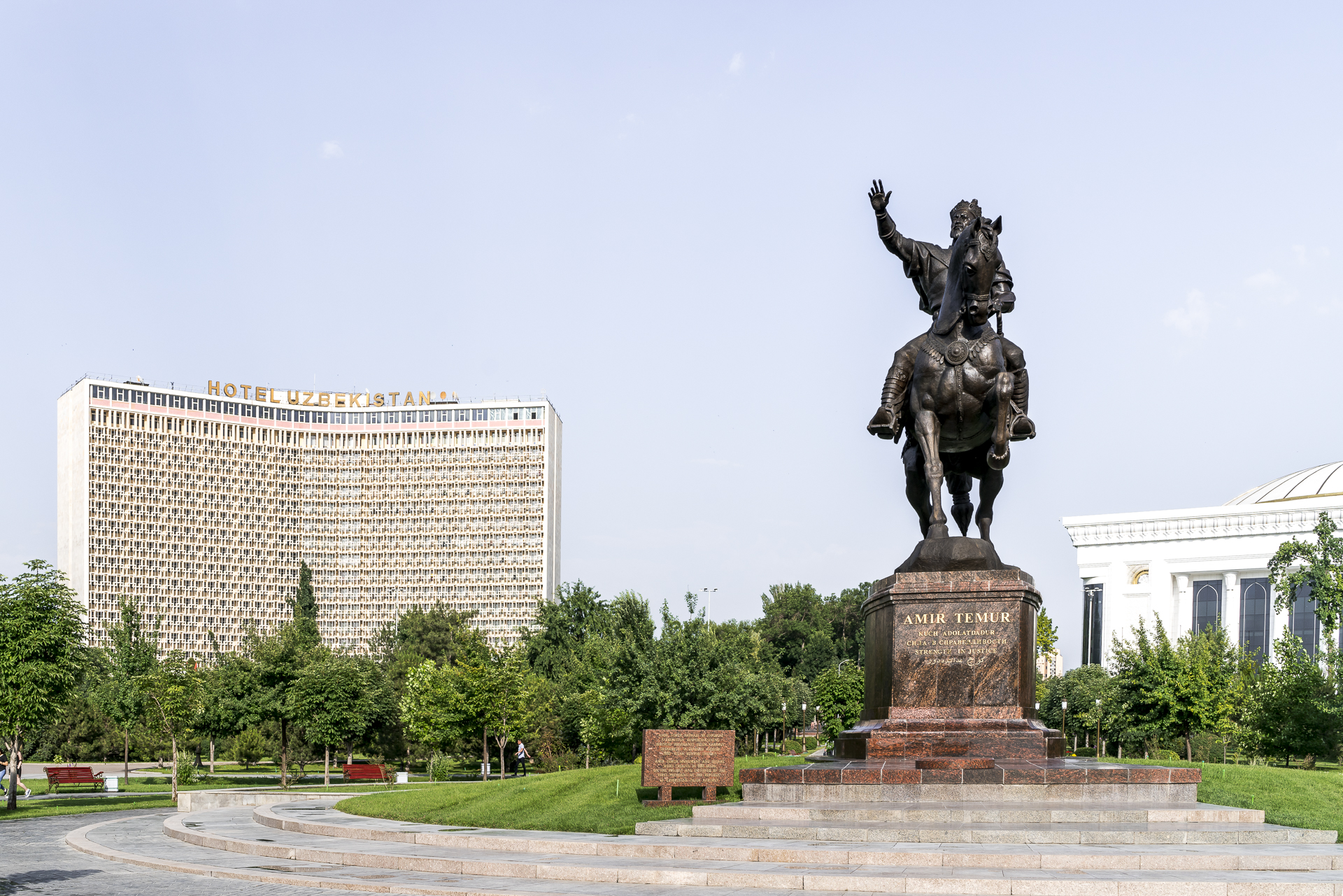
Due to a severe earthquake in April 1966, which destroyed large parts of the former old town, Soviet prefabricated buildings dominate the cityscape today. It is noteworthy that, despite the rapid reconstruction, the architects and planners managed to incorporate traditional elements into the decoration of the façades. These are particularly noticeable at the Hotel Uzbekistan and the History Museum.

In contrast to the Russian New Town with its checkerboard-like streets and wide, tree-lined avenues, the jumble of the oriental Old Town in the west of Tashkent is formed. Here, the small-scale structures as well as some historic buildings have been able to survive. A worthwhile stop in the middle of the hustle and bustle is the Chorsu Bazaar with its imposing market hall and the hustle and bustle all around.

Also worth seeing is the park-like Hast Imam complex, which forms the religious center of Tashkent. A tourist magnet here is the Muji Mubarak Madrasah, where the famous Ottoman Koran is exhibited (Osman was a son-in-law of the Prophet Mohammed). While the other madrasahs and mosques within the complex are freely accessible, we paid an entrance fee of 10,000 Soʻm (about 1.20 CHF) to enter the Muji Mubarak Madrasah.


Practical and a sight in itself is the metro of Tashkent. The metro stations are as imposing as those in St. Petersburg and Moscow. Unfortunately, there was still a strict ban on photos during our visit, which has now been lifted.
In the footsteps of Ulugh Beg in Samarkand
The fastest and most convenient way to get from Tashkent to Samarkand is the Afrosiab. The high-speed train connects the two cities directly in just over two hours. Theoretically, it is possible to order tickets online via the uzrailway website. However, knowledge of Russian is an advantage for this, because the English translation does not transmit place names.
In Samarkand, we stay at the highly recommended Malika Prime Hotel, which is strategically located between Registan and Russian New Town. With two nights on site, we now have 1.5 days after arrival to explore Samarkand. Originally, it was planned that we would visit Samarkand alone on the first day and be on the road with a guide on the second day. When we arrive in Samarkand, we are told – to our surprise – that from this point until the end of the trip, we will be accompanied by a guide. What is meant by the Uzbek agency as a nice gesture (and probably makes things easier for them organizationally) does not trigger any enthusiasm in me at first. I appreciate it when I can get an unfiltered first impression of new places and was looking forward to “experiencing” Samarkand on my own. Without further ado, I give our guide the day off for the first afternoon.
We use the remaining time for a walk through the Russian New Town and the former Jewish quarter. These two areas are usually not visited by guided tours, as they do not include any of Samarkand’s top sights. But I especially liked the Jewish quarter, which is hidden behind inconspicuous wooden walls on the east side of the Registan. The winding alley system is still well preserved (and has not yet fallen victim to the bulldozers). Unfortunately, numerous crumbling adobe buildings indicate that the city has no interest in preserving these historic structures. Unesco has already reprimanded Samarkand in this regard.
The next morning we will be picked up by our guide. Today, the highlights of Samarkand are on the program. First stop: the Gur Emir Mausoleum, which is located right next to our hotel (entrance fee 22,000 Soʻm per person).

Afterwards we walk along Registan Street to Registan – the landmark of Samarkand. Three buildings characterize the majestic square; The Ulugh Beg Madrasah, the Tillya Kari Madrasah and the Shirdor Madrasah. All three buildings originally taught Islamic sciences (hence the term “madrasah”).
The Ulug Beg Madrasah, the oldest building on the square, was built in the 15th century. The other two buildings were added 200 years later. An impressive ensemble that unfolds its full beauty, especially in the evening hours. The entrance fee is 33,000 Soʻm per person – foreign tourists usually pay significantly more than domestic guests. Interestingly, contrary to what was stated in the guidebook, we were nowhere asked for an additional photo fee.
Another attraction in the vicinity of the Registan is the Bibi Khanum Mosque (entrance fee 22,000 Soʻm per person) and the Siyob Bazaar right behind it.
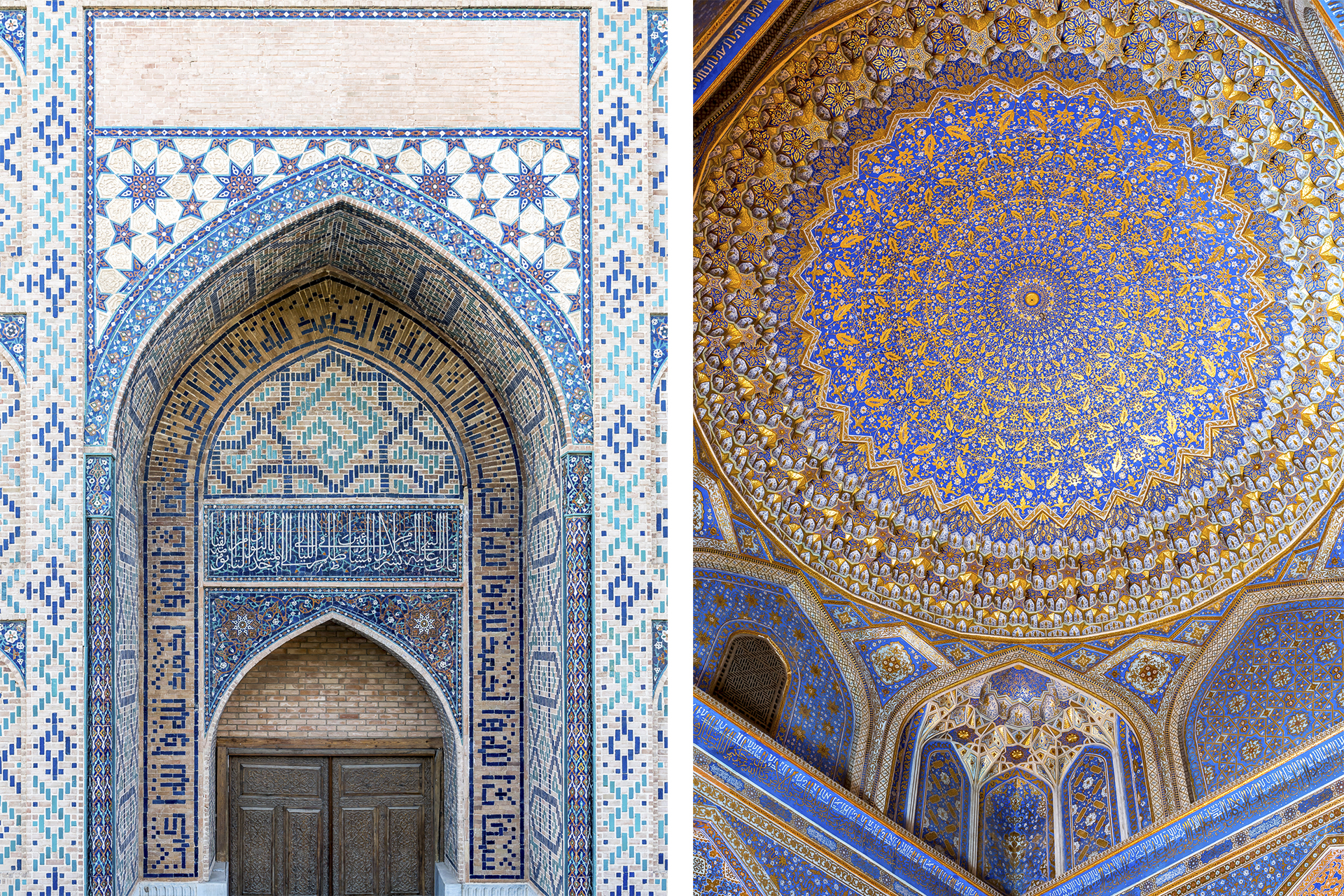
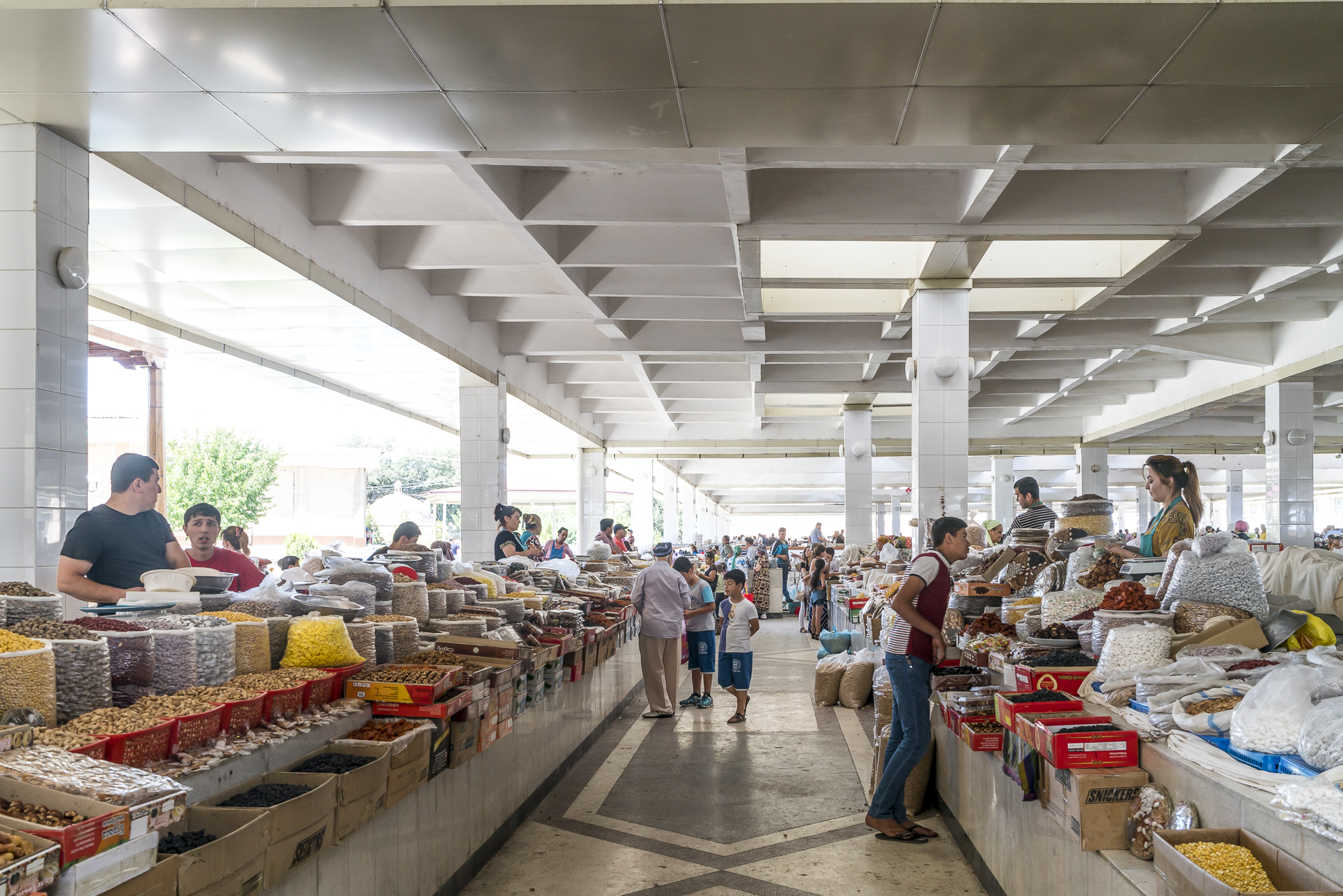
Something that you should definitely include in your tour of Samarkand is a visit to an authentic Plov Center. Plov (pilaf) is one of the national dishes of Uzbekistan and in the so-called Plov Centers, plov is served exclusively around lunchtime. The Plov Center we visited was on its way to the Meros paper mill northeast of the center. A visit to the old paper mill, where paper is made from mulberry bark according to the traditional process, is worthwhile if you are traveling with a driver.

Also outside the center is the Ulugh Beg Observatory. In addition to the restored observatory, where the Timurid prince Ulug Beg carried out astronomical observations from the beginning of the 15th century, there is a modern museum building with information about the scientific activities of the former ruler.

The last stop of our sightseeing tour, before we arrive again in front of the Registan just in time for the Blue Hour, is at the Shah-i Sinda burial town (entrance fee 12,000 Soʻm per person). The visit to the necropolis is exciting, as you can see the entire range of Timurid architecture. Blue tile art as far as the eye can see!


On some evenings, impressive laser shows take place at the Registan. On which days and at what time they are carried out (or whether this depends solely on large groups willing to pay) our guide did not know for sure. On the two evenings we were there, nothing took place. Try your luck and stop by the Registan shortly after dark.
Detour to the Nurata Mountains & Homestay
After this culturally packed day in Samarkand, I am happy that I am now going out into nature again. While many tour operators offer day trips from Samarkand to Shahrisabz – the birthplace of the great Timur – we deliberately skip this detour. Our guide confirms what we have read in various places; As part of “renovation work”, a large part of the old town of Shahrisabz was razed to the ground “in favor of” opulent parks. A “renovation style” that reminds us of the Chinese methods (interestingly, the Chinese also have their fingers in some Uzbek projects). Unesco has reacted and classified Shahrisabz as “vulnerable” on the Red List in 2016.
We are miles away from all this in the Nurata Mountains. The ochre-yellow mountain range stretches between the old royal road connecting Samarkand with Bukhara and Lake Aydar. In the remote mountain villages, you can immerse yourself in the rural life of the Uzbek population in simple homestays. Our hosts at Yahshigul’s Guesthouse in Asraf are Tajiks. This is not as unusual as it seems at first. In the area around Samarkand, Bukhara and the Nurata Mountains, the Tajiks make up a significant proportion of the population. The rooms at Yahshigul’s Guesthouse are simply furnished with two narrow beds and a lamp. There are two shared showers, a dining area and cosy tapchans under shady fruit trees. Only the babbling mountain stream described in the guidebook, which flows right through the property, I don’t hear anywhere. I inquire with our hosts and learn that last winter there was no snow and the spring dried up. Now they are resorting to groundwater. It is to be hoped that next winter will bring much-needed snow to this barren landscape!
In the evening we help our hosts to prepare the plov ingredients and are served a really fine dinner afterwards.




We also spend two nights here so that we have enough time for a day hike to the neighboring village of Uhum. There are also offers where you can hike with donkeys from one mountain village to the next and spend the night in a different guesthouse. You can find information about the various offers on the website of Nuratau Responsible Travel. Unfortunately, we did not see any of the native and endangered Kyzilkum wild sheep on our hike. On the other hand, we encountered numerous curious goats.

Yurt night in the Kysylkum desert
If you travel to Uzbekistan, you won’t get to see any yurts except for the few yurt camps for tourists. Unlike Kyrgyzstan, Kazakhstan and Mongolia, where the yurt is still widely used today, mud houses have become the dominant traditional dwelling in Uzbekistan. The yurt camp (Kyzyl Kum Safari Yurt Camp) not far from the shores of Lake Aydar is then also run by a Kazakh family. I find it exciting that Lake Aydar was created in 1969 as an unintentional by-product of Soviet planning. Until then, the area was a dry salt pan with seasonal brackish water lakes. The detour to Lake Aydar can also be included in a transfer to Bukhara without an overnight stay in a yurt camp.
My recommendation: Don’t spend the night in the yurt camp and instead plan three nights in different guesthouses in the Nurata Mountains.


Magnificent historical buildings in Bukhara
After the night in the yurt, the journey takes us via Navoi to Bukhara. On the recommendation of our guide, we make a stop at the caravanserai Rabat-i Malik a good 20 kilometers before Navoi. The ruins are witnesses of the era when trade on the Silk Road flourished. Only the main portal has been preserved in its original state, but in contrast to many other historical buildings in Uzbekistan, there has been no major “messing around”. Thanks to the visible foundations, you get an idea of how many rooms the 91×89 m building was equipped with. On the opposite side of the road there is also a restored water reservoir from the 14th century, which is still fed with water via an underground irrigation system (Karez).

Another worthwhile detour on the way to Bukhara is the Narzullaev pottery in Gijduvan. In every region of the country there are pottery schools and accordingly also local styles and motifs. The Narzullaev family’s farm offers a nice insight into the traditional production process of ceramic tableware and the prices for both the ceramic products and the suzani (traditional Uzbek silk embroidery) are very fair compared to the souvenir shops in Bukhara, Khiva and Samarkand.

In Bukhara, we spend the night at the beautifully designed Hotel Sasha & Son, which is ideally located for exploring the city’s main attractions on foot. The origins of Bukhara date back to ancient times and the density of historical buildings is impressive. Unfortunately, not everything was restored with the same care and in some places historical structures had to give way in favor of the better staging of the individual sights.
We start our tour in the west of the city at the Samanid Mausoleum in the park of the same name. The tomb of Ismail Samani is the oldest surviving testimony of Islamic architecture in Central Asia. At the edge of the park there is another mausoleum with a spring fountain, which, according to legend, Job carved out of the rock with a staff. This also explains the name of the mausoleum, which is called “Job’s Well“.
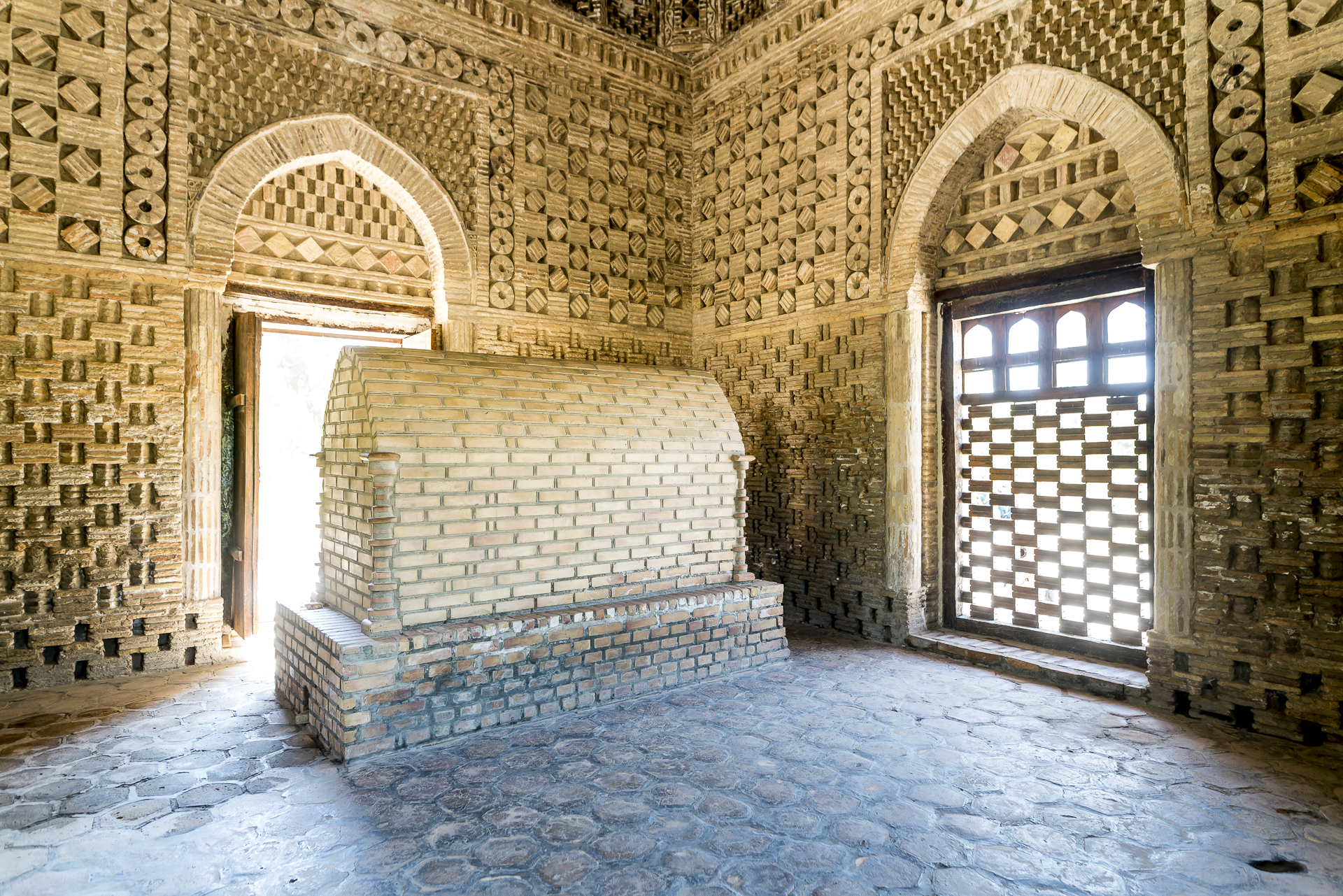
Afterwards we visit the Bolo Hovuz Mosque with its imposing wooden columns and the Ark directly opposite it – the massive citadel is one of the city’s landmarks (entrance fee 15,000 Soʻm per person).
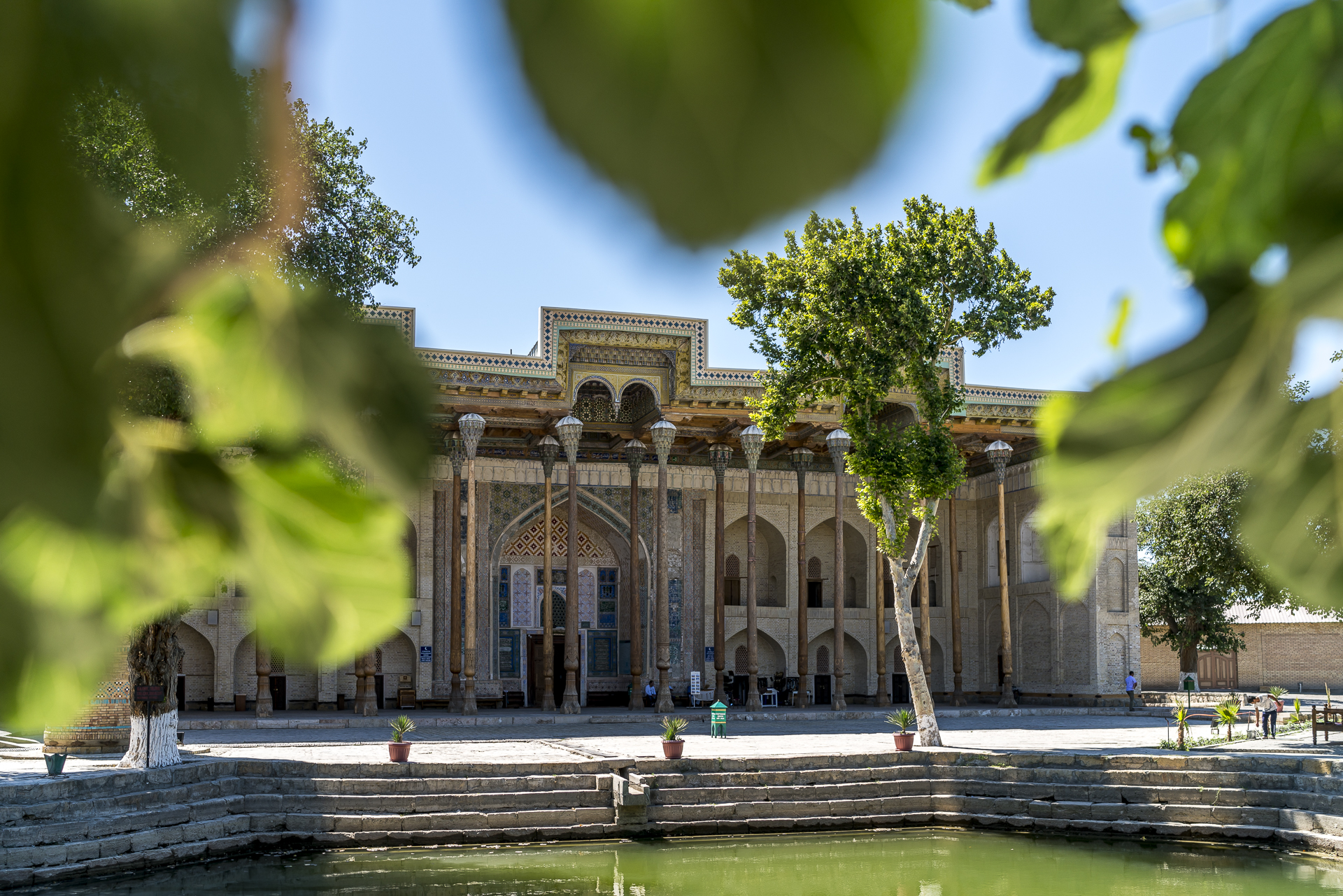

Another landmark is the Kalon complex with the minaret of the same name. It is impressive that the 45 m high tower dates back to pre-Mongol times and Genghis Khan was supposedly so impressed by this structure that he did not destroy it, unlike the rest of the city. Unfortunately, the tower is no longer accessible today, but you can visit the Kalon Mosque right next to it. The ensemble of the square also includes the Mir-i-Arab Madrasah, which is the only madrasah in the country that has been used almost continuously as a religious educational institution since the 16th century to the present day (only under Stalin’s rule did it remain closed for 16 years).
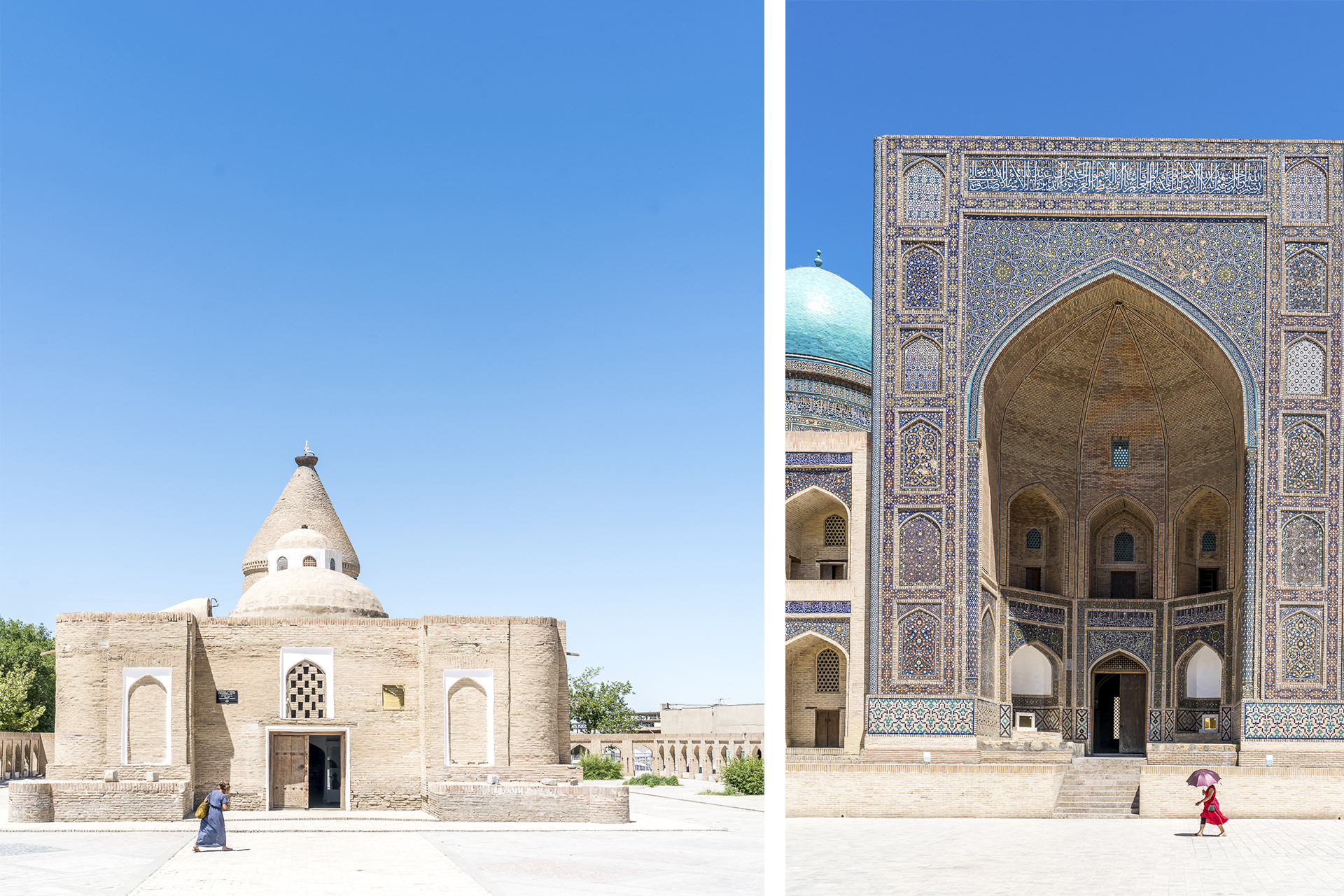


Somewhat hidden in a residential area is the striking Chor Minor Madrasah, of which only the gate building has been preserved, but it has its very own appearance with its four striking towers.
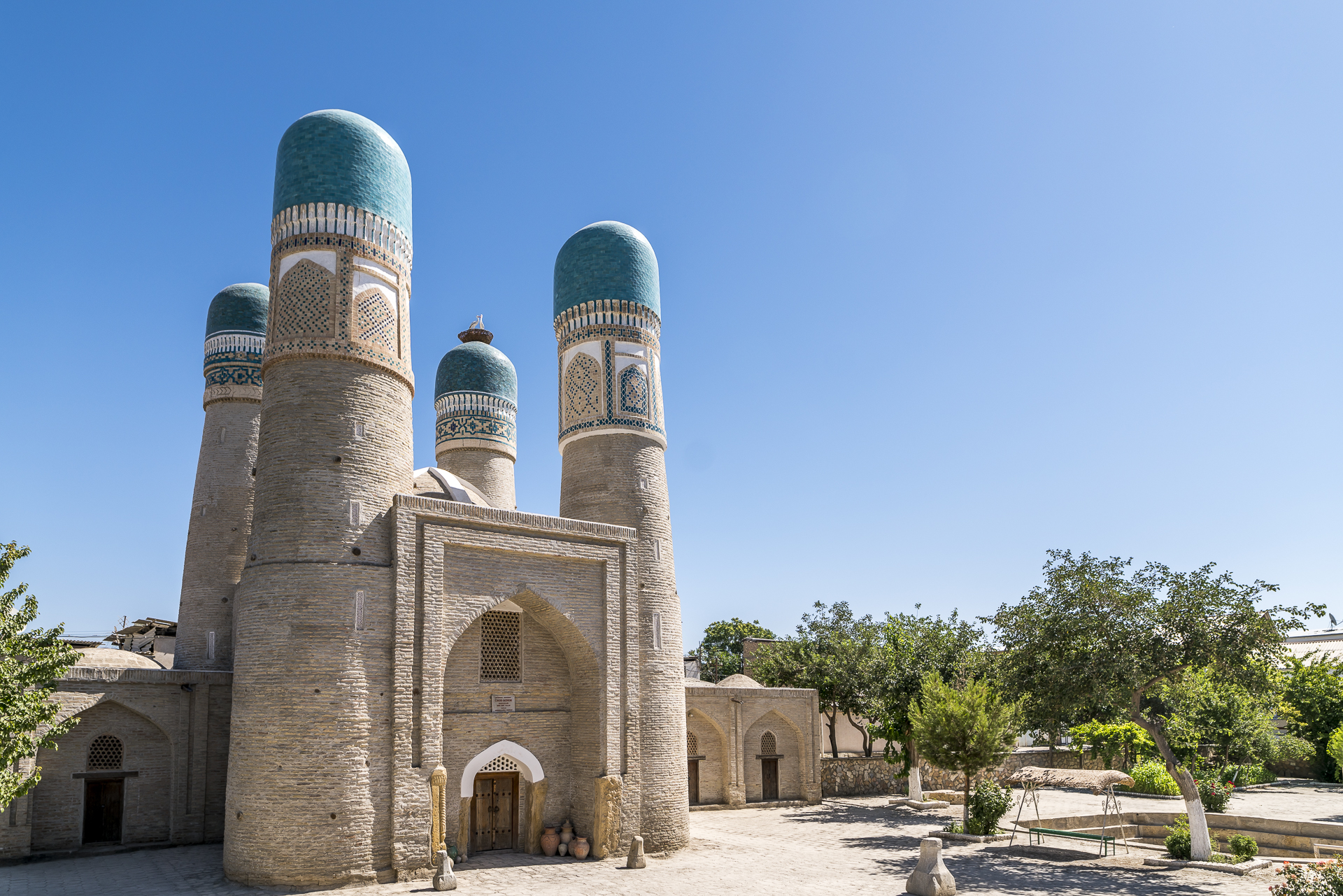
Bukhara is so packed with sights that it’s definitely worth planning two full days for sightseeing. In addition to the spots already mentioned here, there is also a well-preserved Jewish quarter, the “Labi Chaus” building complex around the artificial ponds in the center and the domed bazaars with carpet and spice merchants. Not far from Labi Chaus, it is also worth taking a look at the shop of the doll maker Khakimov, who produces dolls here according to the old Bukharian tradition.
All in all, Bukhara probably corresponds most closely to the “Arabian Nights” scenery with which a journey along the Silk Road is often described. On the other hand, Bukhara seems a bit “sophisticated” in the centre and is more clearly influenced by tourism than Samarkand.
Enchanting Khiva & Khorezmian culture
Only Khiva can top Bukhara. Once the capital of Khiva Khanate in Khorezmia, the walled old town of Khiva is now home to over 50 historical buildings. To visit the individual sights, you pay a flat rate entrance fee (100,000 Soʻm per person) when you pass through the city gates. If you just want to stroll through the alleys, you don’t have to buy an entrance ticket!
We spend the night in Khiva again in a hotel of the Malika group, which is located directly opposite the main entrance to the old town. Even though the monuments of Khiva are not as old as those in Samarkand or Bukhara, I really liked the surprisingly well-preserved and compact cityscape from the 19th century. We were lucky that we traveled to Uzbekistan in the off-season and were spared the rush of tour groups. In the meantime we had the alleys of Khiva to ourselves. However, I can well imagine that the narrow paths quickly seem overpopulated and the city then also loses its relaxed flair.

My highlights in Khiva are the city wall (one access to the wall is at the north gate), the mystical Juma Mosque with its striking wooden columns and the 57 m high Islam Hodja Minaret, which offers the best view of the city with its viewing platform. For the climb to the tower you pay 10,000 Soʻm extra per person, but it’s definitely worth it!







Blatant contrasts in Karakalpakstan
Samarkand, Bukhara and Khiva are an integral part of a classic Uzbekistan round trip program. Significantly fewer tourists travel further north to the autonomous republic of Karakalpakistan. One term here is the Aral Sea, but we excluded it from our itinerary. I wanted to visit Nukus, the capital of Karakalpakistan. The city itself does not have any particular charm, but the Igor Savitsky Museum houses an extraordinary collection of Russian and Soviet avant-garde art. Now, it’s not like I’m particularly knowledgeable about this area. But I thought this was an exciting contrast to the previous itinerary, which is characterized by Islamic architecture.
The three-hour drive over bumpy provincial roads (200 kilometres) from Khiva to Nukus can be broken up with stops at one of the numerous “kalas”. The fortified settlements, of which only ruins remain today, date back to a time when the Amudarya ran further east and southern Karakalpakistan was blessed with fertile alluvial land. We visit the fortifications Ayaz Kala 1 and 2, with the higher and larger fortification Ayaz Kala 1 offering the best panoramic view of the desert landscape.

Our stay in Nukus falls on a Sunday/Monday and the visit to the museum is actually scheduled for Monday. At the last minute, we are horrified to discover that the museum is now closed on Mondays. Unfortunately, there are two different websites, one of which is easier to find, but the information on it is outdated. You can find the latest information here: Karakalpakstan State museum of Art. Overall, the exhibition didn’t knock me off my feet. Most of the rooms were poorly lit (half of the lamps were not switched on) and accordingly the individual works of art did not really come into their own. Nevertheless, this additional loop to Nukus was worth it – if only to get a more holistic picture of Uzbekistan.
p.s. by the way, the Savitsky Museum was the only place where we would have had to pay extra for taking pictures. But the fee of 192,000 Soʻm was not worth it to us.

From Nukus we take the plane via Tashkent back to Switzerland. While other travelers end their long-term trip with relaxed beach vacations, we ended our 6-month trip to a bizarre art museum in the middle of Central Asia – I would think that fits quite well!
Good to know: do you need a visa for Uzbekistan?
We traveled to Uzbekistan in June 2018, which was probably the stupidest possible time in terms of visas. Until the end of June 2018, Swiss citizens needed a visa to travel to Uzbekistan, which they had to obtain at the Embassy of the Republic of Uzbekistan in Berlin, as Uzbekistan does not have a representation in Switzerland. So we had to send our passports to Germany, which was associated with corresponding costs.
Since July 2018, this is no longer necessary. At that time, Uzbekistan introduced the e-Visa for certain states. Now you can apply for your visa online for a fee of $20. A helpful step-by-step guide can be found here: how to apply for an electronic visa for Uzbekistan. I have linked the official visa page here: Official electronic visa portal of the Republic of Uzbekistan
Update January 2019: From 1 February 2019, entry into Uzbekistan is visa-free for citizens of Switzerland, Germany and Austria. This is valid for stays of up to 30 days. Citizens from other countries can still apply for the visa via the e-Visa tool linked above.
More practical tips for your trip to Uzbekistan
- The official language of Uzbekistan is Uzbek, as well as the Karakalpak language in Karakalpakistan, with a large part of the population also understanding Russian. If you travel through the country individually without a guide/driver, I recommend that you acquire a basic vocabulary of Russian.
- The official currency in Uzbekistan is called Soʻm. However, dollars are still a popular means of payment, as the soʻm is exposed to a high inflation rate. We had no trouble withdrawing Soʻm with our credit card (Visa) at selected ATMs in Tashkent and Samarkand and did not have to visit any exchange offices (EC cards, on the other hand, are not accepted at any ATM). Just be prepared for the fact that you will receive a huge mountain of banknotes and a single note is hardly worth anything. It’s best to take dollars with you as a backup.
- From 1991 to 2016, Islom Karimov was President of Uzbekistan and shaped the introverted and repressive development of the country over the past 25 years. Under the new president Shavkat Mirziyoyev, a slow opening has been taking place since the beginning of 2017.
- April/May and September/October are considered the best time to visit Uzbekistan. However, most tour groups are also on the road during these periods. We toured the country in June and loved it. The temperatures were bearable – only in Bukhara and Khiva did we experience days when it got over 30° warm.
- Samarkand, Bukhara and Nukus are directly accessible by train from Tashkent. Alternatively, shared taxis (normal cars) or marshrutkas (minibuses) are the cheapest and most popular means of transport for the locals. However, the majority of tourists travel with a driver.
- If you want to eat cheaply, it’s best to stop off at tea houses. Traditional dishes such as plow, manti, laghman and shish kebab are usually served here. In Khiva, you should definitely try the green noodles – this is a local specialty. In tea houses and plow centers, you pay between 30,000 and 40,000 soʻm (around 4 to 5 CHF) for lunch for two. In more touristy restaurants, a meal for two costs around 100,000 soʻm (around 12 CHF).
- To visit most of the sights, an entrance ticket must be purchased on site. Prices vary between 10,000 and 30,000 Soʻm per attraction for foreign tourists. Mosques that are still actively used as such, on the other hand, can usually be visited free of charge, although a small donation is welcome on site. Women are not expected to wear a headscarf during the tour.
- We had the Uzbekistan travel guide from Dumont Verlag with us and found it well prepared and informative (although in the 2017 edition some information was already outdated again – especially price information).
Note: our trip to Uzbekistan was supported by Globotrek. All impressions and opinions are, as always, ours.


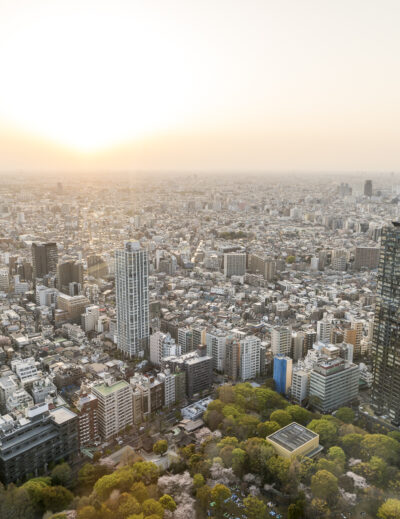
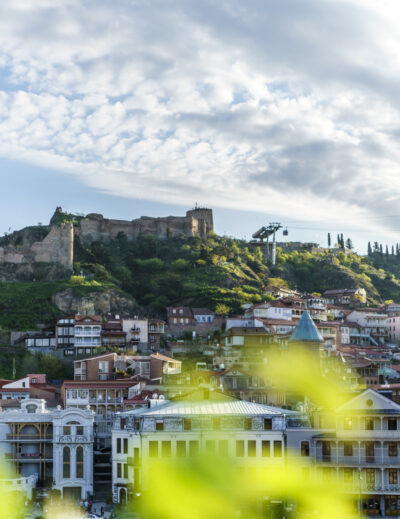
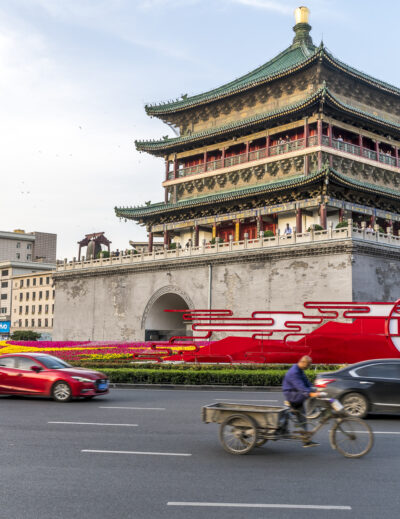
Leave a Reply